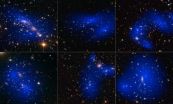Bats obey 'traffic rules' when trawling for food
2015-03-26
(Press-News.org) Foraging bats obey their own set of 'traffic rules', chasing, turning and avoiding collisions at high speed, new research from the University of Bristol, UK has found.
Dr Marc Holderied of Bristol's School of Biological Sciences studied pairs of Daubenton's bats (Myotis daubentonii) foraging low over water for stranded insects at a site near the village of Barrow Gurney in Somerset, UK.
He said: "Collective movements of flocking birds or shoaling fish are amongst the most fascinating natural phenomena, and everyone has experienced the challenges of walking through a moving crowd. What information individuals use for movement coordination is, however, very difficult to know - except in the case of echolocating bats."
These flying mammals perceive their surroundings by emitting loud and high-pitched biosonar calls and listening for the returning echoes. Because bat biosonar imaging is much sparser in information than vision, Dr Holderied was able to accurately measure the biosonar calls of the interacting bats and then calculate what each of the individuals perceived.
The results indicated that bats obey their own intriguing set of 'traffic rules': they chase each other, perform tandem turns and even slow down to avoid collision.
Together with Dr Luca Giuggioli from the Bristol Centre for Complexity Sciences and Thomas McKetterick from the Department of Engineering Mathematics, Dr Holderied modelled the bats' biosonar view of their surroundings during these interactions and discovered that one simple trick suffices to create all the bats' interactive behaviours.
They swap leader-follower roles and perform chases or coordinated manoeuvres by copying the heading a nearby individual was using up to 500 milliseconds earlier. (500ms is almost as fast as the blink of a human eye which has been measured at 300-400ms).
Dr Holderied said: "The bats seem to have adopted a simple trick: once another individual is close enough for your biosonar to pick up its echo, copy this individual's flight direction within four to five of your own wingbeats."
Dr Luca Giuggioli said: "Quantifying the movement decisions that bats adopt to forage has implications well beyond animal ecology. By employing movement strategies that nature has optimized over millions of years engineers may be able to improve the efficiency of search and rescue missions, monitoring tasks, and surveillance operations in the emerging market of flying drones and autonomous moving vehicles."
INFORMATION:
The study is published today in PLOS Computation Biology.
Paper
'Delayed Response and Biosonar Perception Explain Movement Coordination in Trawling Bats' by Luca Giuggioli, Thomas J. McKetterick and Marc Holderied in PLOS Computational Biology.
ELSE PRESS RELEASES FROM THIS DATE:
2015-03-26
CHAPEL HILL, NC - A team of researchers has discovered HIV can begin replicating in the brain as early as four months after initial infection. The study followed 72 treatment naïve participants during the first two years of HIV infection. Through analysis of cerebral spinal fluid (CSF) and blood samples, 20 percent of subjects showed replication in the central nervous system (CNS) at four months. Additionally, 30 percent of participants showed evidence of a marked CSF inflammatory response in at least one time point and 16 percent of study volunteers showed a marked ...
2015-03-26
The fact that the neutron is slightly more massive than the proton is the reason why atomic nuclei have exactly those properties that make our world and ultimately our existence possible. Eighty years after the discovery of the neutron, a team of physicists from France, Germany, and Hungary headed by Zoltán Fodor, a researcher from Wuppertal, has finally calculated the tiny neutron-proton mass difference. The findings, which have been published in the current edition of Science, are considered a milestone by many physicists and confirm the theory of the strong interaction. ...
2015-03-26
Astronomers using observations from the NASA/ESA Hubble Space Telescope and NASA's Chandra X-ray Observatory have studied how dark matter in clusters of galaxies behaves when the clusters collide. The results, published in the journal Science on 27 March 2015, show that dark matter interacts with itself even less than previously thought, and narrows down the options for what this mysterious substance might be.
Dark matter is a giant question mark looming over our knowledge of the Universe. There is more dark matter in the Universe than visible matter, but it is extremely ...
2015-03-26
Say you're out shopping for basic household goods -- perhaps orange juice and soup. Or light bulbs. Or diapers for your young child. How do you choose the products you buy? Is it a complicated decision, or a simple one?
It could be complex: Factors like price, quality, and brand loyalty may run through your mind. Indeed, some scholars have developed complicated models of consumer decision-making, in which people accumulate substantial product knowledge, then weigh that knowledge against the opportunity to explore less-known products.
But in a new paper, MIT researchers ...
2015-03-26
(WASHINGTON - March, 26, 2015) - A committee of lymphoma experts today unveiled a strategic roadmap identifying key priority areas in both infrastructure and research that will be critical for advancing treatments for people with lymphoma. The report is meant to inform future research directions as well as funding decisions by strategic partners that could include government agencies and the private sector. The strategic recommendations were developed after a review of the state of the science in lymphoma conducted at a special ASH Meeting on Lymphoma Biology held in August ...
2015-03-26
EAST LANSING, Mich. -- It may sound like the makings of a joke, but answering the question of how chickens crossed the sea may soon provide more than just a punch line.
Michigan State University researcher Eben Gering has collaborated with a team in a study of the mysterious ancestry of the feral chicken population that has overrun the Hawaiian Island of Kauai. Their results, published in the current issue of Molecular Ecology, may aid efforts to curtail the damage of invasive species in the future, and help improve the biosecurity of domestic chicken breeds.
Domesticated ...
2015-03-26
Washington, DC (March 26, 2015)--As the world looks to American innovation to fight Ebola, malaria, tuberculosis, and a host of other health threats, a new report released today on Capitol Hill warns budget battles in Washington are eroding preparedness at home and abroad at a time when scientific advances are poised to deliver new lifesaving drugs, vaccines, and diagnostics.
"Since 2009, we've seen declining, or at best stagnating, support for global health research and development, with politics trumping prudent investments that could protect the US and the world from ...
2015-03-26
The expansion of no-take marine reserves (NTMRs) within Australia's Great Barrier Reef Marine Park more than a decade ago is working to protect fish just as experts had hoped it would, say researchers who have been monitoring the reef via underwater surveys. The findings, reported in the Cell Press journal Current Biology on March 26, come as encouraging news for Australia's largest reef and for other, similar projects around the world.
While the park reserves could not protect the reef directly from extensive physical damage caused by Tropical Cyclone Hamish in 2009, ...
2015-03-26
CHAMPAIGN, Ill. -- Using high-performance computing and genetic engineering to boost the photosynthetic efficiency of plants offers the best hope of increasing crop yields enough to feed a planet expected to have 9.5 billion people on it by 2050, researchers report in the journal Cell.
There has never been a better time to try this, said University of Illinois plant biology professor Stephen P. Long, who wrote the report with colleagues from Illinois and the CAS-MPG Partner Institute of Computational Biology in Shanghai.
"We now know every step in the processes that ...
2015-03-26
Scientists have revealed a brand new function for one of the first cancer genes ever discovered - the retinoblastoma gene - in a finding that could open up exciting new approaches to treatment.
The retinoblastoma gene is so called because mutations to it cause a rare children's eye cancer of the same name, and is known to play a central role in stopping healthy cells from dividing uncontrollably.
Now the new study - jointly led by scientists at The Institute of Cancer Research, London, and UCL (University College London) - has found that the gene also has another important ...
LAST 30 PRESS RELEASES:
[Press-News.org] Bats obey 'traffic rules' when trawling for food




